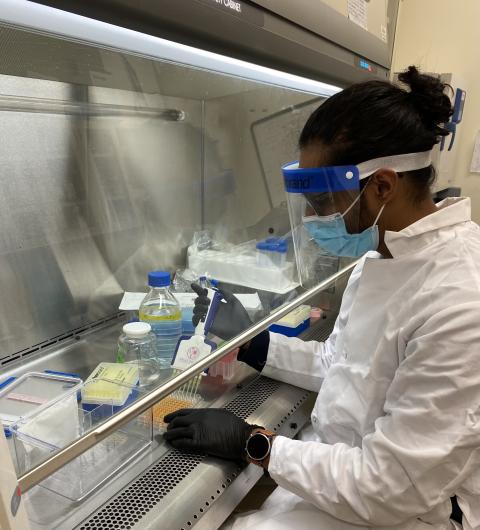In New Hampshire, over 1,300 residents are diagnosed with Lyme disease each year (Eaton, 2018). Lyme disease is a condition caused by the bacterium Borrelia burgdorferi (B. burgdorferi) and it is the most common vector-borne disease in the United States. The disease is spread primarily through the bite of the blacklegged tick (Ixodes scapularis), and this bite transfers B. burgdorferi to the bloodstream, where it spreads throughout the body. The symptoms of Lyme disease can include circular rashes, fever, fatigue, swollen glands, and joint pain. If left untreated, more serious symptoms such as meningitis, facial palsy, arthritis, or heart irregularities can occur.

It has been estimated that approximately 60 percent of blacklegged ticks in the New Hampshire are infected with B. burgdorferi (Eaton, 2018). Currently, antibiotics are the major form of treatment for Lyme disease. However, the Lyme disease bacterium has been shown to display characteristics of antibiotic resistance (Rudenko et al., 2019). The need for alternative treatments for Lyme disease is a pressing matter.
Enter the bacteriophage. Just like other forms of life, bacteria have natural predators, and the bacteriophage is quite the apex predator. Bacteriophages are a specific type of virus that can be found in all aspects of nature, and they are the most abundant life-form on Earth (Haq et al., 2012). Bacteriophages infect and destroy bacteria, and each type of bacteriophage possesses an extremely selective host range. Due to this great specificity, they have many advantages as a therapeutic agent in the age of antibiotic resistance.
The aim of my project was to isolate a bacteriophage for Borrelia burgdorferi with the potential to be used as an alternative therapeutic agent against Lyme disease. All work was conducted in the microbiology research laboratory at the University of New Hampshire at Manchester and was funded by UNH’s Summer Undergraduate Research Fellowship (SURF) program. This project was arranged in the following stages: tick processing; identification of ticks carrying B. burgdorferi; and bacteriophage identification.
Bacteriophages are found in environments where their host bacterium is also found, so any tick samples that are positive for B. burgdorferi are good candidates for identifying the presence of the virus, or bacteriophage, that infects the Lyme disease bacterium as well. I was fortunate enough to get in contact with Dr. Kaitlyn Morse of Bebop Labs in Salisbury, New Hampshire, who graciously donated samples of blacklegged ticks for my project. Each tick was crushed with a mortar and pestle and inoculated into a liquid media to be incubated.
The liquid media was already growing the host bacterium, B. burgdorferi, and that allowed bacteriophages that infect B. burgdorferi to thrive in the sample. Simultaneously, I established pure B. burgdorferi in liquid culture by following suggested culture methods. This liquid culture was used in the later stages of the project.
To identify ticks that were positive for the Lyme disease bacterium, I isolated DNA from tick samples, and I used polymerase chain reactions (PCR) with primer sets designed for the identification of Borrelia burgdorferi. When a DNA fragment of expected size showed up on an agarose gel, this indicated that the sample was positive for Lyme disease.
Using the positive tick samples, I performed an enriched isolation procedure to increase the concentration of bacteriophage. To do so, I filtered these samples to remove all bacteria and leave samples of just bacteriophage. The filtered products were added to the small samples of the pure B. burgdorferi liquid culture that were created earlier and left to incubate. This allowed time for the bacteriophages to spread and infect the pure B. burgdorferi, which would increase the concentration of bacteriophages. To keep the viruses alive and replicating, I filtered and re-inoculated these enriched cultures with fresh bacteria at regular intervals.
The next phase of the project involved testing for bacteriophages in our positive samples. To do this, I infused both a pure culture of B. burgdorferi and the positive enriched samples in a liquid agar media that solidifies when cooled on petri dishes. After another incubation period, bacterial colonies should develop and merge together to form a “lawn,” or mat, covering the solid medium. Plaques, which are visible, clear, circular areas, form on this solid medium when bacteriophages infect and destroy bacteria. Bacteriophage can then be purified from a plaque through serial dilutions.
Unfortunately, this phase of the project was unsuccessful due to the fact that a bacterial lawn did not form in the petri dishes. This was the major sticking point for my project and was the primary reason that I was not able to finish my research over the summer. Thankfully, this is an ongoing project, and I am currently pursuing other methods to test for the presence of our desired bacteriophages using targeted primers. This approach helps evade the issue of having to create a lawn of B. burgdorferi. As of December 2021, I have just begun the initial phase of testing with successful results and hope to continue down this pathway with even more success.
I would like to thank my faculty mentor, Dr. Kyle MacLea, for providing me with guidance and support throughout this project. I would like to thank Mr. Keith Legro for his support in ordering necessary supplies and maintenance of the laboratory. I am also grateful to Dr. Kaitlyn Morse for the donation of ticks to support this project. Finally, I would like to extend my thanks to the Hamel Center for Undergraduate Research staff and Mr. Dana Hamel for their support through the Summer Undergraduate Research Fellowship (SURF).
References
Eaton, A. (2018, April 17). Biology and Management of Ticks in New Hampshire [fact sheet]. UNH Cooperative Extension. https://extension.unh.edu/resource/biology-and-management-ticks-new-hampshire-fact-sheet
Haq, I. U., Chaudhry, W. N., Akhtar, M. N., Andleeb, S., & Qadri, I. (2012). Bacteriophages and their implications on future biotechnology: A review. Virology Journal, 9(1), 9. https://doi.org/10.1186/1743-422X-9-9
Rudenko, N., Golovchenko, M., Kybicova, K., & Vancova, M. (2019). Metamorphoses of Lyme disease spirochetes: Phenomenon of Borrelia persisters. Parasites & Vectors, 12(1), 237. https://doi.org/10.1186/s13071-019-3495-7
Copyright 2021, Fardeen A. Siddiqui
